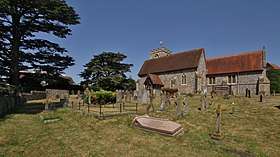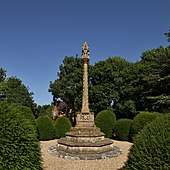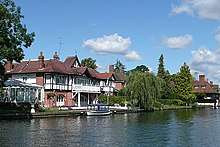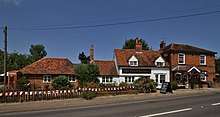Shiplake
Shiplake consists of 3 settlements: Shiplake, Shiplake Cross and Lower Shiplake. Together these villages form a civil parish situated beside the River Thames 2 miles (3 km) south of Henley-on-Thames, Oxfordshire, England. The river forms the parish boundary to the east and south, and also the county boundary between Oxfordshire and Berkshire.
| Shiplake | |
|---|---|
 Parish church of SS Peter and Paul | |
 Shiplake Location within Oxfordshire | |
| Area | 4.44 km2 (1.71 sq mi) |
| Population | 1,954 (2011 Census) |
| • Density | 440/km2 (1,100/sq mi) |
| OS grid reference | SU7678 |
| Civil parish |
|
| District | |
| Shire county | |
| Region | |
| Country | England |
| Sovereign state | United Kingdom |
| Post town | Henley-on-Thames |
| Postcode district | RG9 |
| Dialling code | 0118 |
| Police | Thames Valley |
| Fire | Oxfordshire |
| Ambulance | South Central |
| UK Parliament | |
| Website | Shiplake Villages |
The villages have two discrete centres separated by agricultural land. The largest is Lower Shiplake, centred around Shiplake railway station on the Henley Branch Line. It is the economic centre of the parish and contains a store & post office, butcher shop, The Baskerville pub as well as most of the homes in the parish. 1 mile (1.6 km) southwest of Lower Shiplake are the older, contiguous settlements of Shiplake and Shiplake Cross. Shiplake village is the historic and religious centre of the parish and contains Shiplake Farm, the Parish church of SS Peter & Paul on Church Lane, Shiplake House, Plowden Arms pub and Shiplake College independent boarding school. The College occupies the building and site of the historic Shiplake Court. Shiplake village contains numerous Grade II* and II listed buildings and monuments. Shiplake Cross is the sporting and community centre of the parish. It consists of just five roads: Memorial Avenue, Orchard Close, Plough Lane, Plowden Way and Schoolfields. It contains the Shiplake Memorial Hall, Shiplake Village Bowling Club (founded 1920) and Shiplake Tennis & Social Club as well as Shiplake CE Primary School and Nursery.
Historically, the parish also included Binfield Heath, 1 mile (1.6 km) west of the historic Shiplake village. Since 2003 it has been a separate civil parish.
The 2011 Census records the parish (on its adjusted scale) population as 1,954 and containing 679 homes.[1][2]
The A4155 main road linking Henley with Reading, Berkshire passes through the parish.
Toponym
The earliest known surviving records of the toponym "Shiplake" are from the 13th century. The Book of Fees records Sciplak in 1236 and the Taxatio Ecclesiastica records Schipelak in 1292. It is derived from Old English and means "stream where sheep were washed".[3] The other supposed origin is a mix of Saxon (Scip=ship) and Danish (Lack= to want or not to possess) 'lack of ships' and may relate to a Viking practice of sinking boats as a cache. Vikings raided the Thames and attacked Reading in 871. The Viking option was [4] preferred by Emily J Climenson in her 1894 tome, 'The History of Shiplake'.
Parish church
The Church of England parish church of SS Peter and Paul dates from at least the 13th century and is the centre of the Church of England parish of Shiplake. In 1869 the church was restored and enlarged to designs by the Gothic Revival architect GE Street. The chancel, north aisle and parts of the south aisle were rebuilt and the tracery of all its windows were replaced.[5] The church is a Grade II* listed building.[6]
The church tower has a ring of eight bells, all recast by the Whitechapel Bell Foundry in 2009.[7] Shiplake Church also has a Sanctus bell cast by Gillett & Johnston of Croydon in 1929.[7] The earliest reference to Shiplake’s bells is in an inventory dating from the reign of Edward VI (1547–53): "Item – Three belles in ye steeple".[8] The church bells were rung for Alfred Lord Tennyson's wedding on 13 June 1850. The ceremony was performed by the Reverend Robert Rawnsley who was Vicar from 1849-62. Tennyson gave the vicar a poem in lieu of payment for the ceremony: Vicar of that pleasant spot, Where it was my chance to marry, Happy, happy be your lot, In the vicarage by the quarry: You were he that knit the knot.[9]

In the churchyard is a Gothic Revival shaft cross. It was erected in 1908 as a monument to a member of the Phillimore family. It is Grade II listed.[10]
Economic and social history
In 1773 the Thames Navigation Commission built Shiplake Lock on the River Thames about 1⁄2 mile (800 m) downriver from the main village.
About 1830 Shiplake House was built.[11] It is a three-storey early 19th-century Regency house just east of what is now Shiplake College. Part of the rear and side has a decorative wrought iron verandah.[12]
In 1857 the Great Western Railway opened the Henley branch line between Twyford and Henley-on-Thames, crossing the Thames on Shiplake Railway Bridge, about 300 yards (270 m) downstream from Shiplake Lock. The GWR built Shiplake railway station at Lower Shiplake, 1 mile (1.6 km) northeast of the older part of the village. Lower Shiplake has since grown into the largest settlement within the parish.
The original railway bridge was of timber. In 1897 the GWR replaced it with the present iron bridge.
In 1889 the author Jerome K. Jerome featured Shiplake in his novel Three Men in a Boat.[13]

Most homes in Shiplake were built or rebuilt after the railway arrived. These include Shiplake Court, an historic estate and country house beside the parish church that overlooks the Thames. Shiplake Court was re-built between 1890[14] and about 1905.[15] In 1959 it became Shiplake College, an independent boarding school.[16] Some of the college buildings are Grade II listed, including its "extraordinary"[11] water tower.[17]
In 2003 the village of Binfield Heath and hamlet of Crowsley were separated from Shiplake civil parish to form the new civil parish of Binfield Heath.[18] Binfield Heath and Crowsley remain part of the Church of England parish of Shiplake, as does Eye and Dunsden to the south.
Amenities

Shiplake has a villages website where news and information is exchanged. The website address is http://www.shiplakevillages.com/index.php?pid=58 . This website also contains vital information. In 2020 the villages' Covid-19 response and numbers to contact was driven from this site http://www.shiplakevillages.com/forum-thread.php?thread=941#.
Shiplake has two pubs: the Plowden Arms and The Baskerville. The Plowden Arms in Shiplake village shut 'suddenly' on New Year's Day 2019.[19] It is widely hoped it will re-open. The Baskerville is located in Lower Shiplake, near the railway station.
Shiplake has a village hall,[20] Women's Institute,[21] amateur dramatic society,[22] bowls club[23] and lawn tennis club[24] and many other clubs such as the art and history societies and various fitness groups.
Shiplake has a small number of industrial, storage, retail, distribution and office units.[2]
Primary schooling takes place at Shiplake CE Primary School on Memorial Avenue, a Voluntary Aided Church of England school with a school role of 178.[25] Older children attend nearby Gillotts School in Henley. Shiplake College is an independent day and boarding school for boys aged 11– 18 and girls aged 16–18, located just off the main A4155 Henley to Reading road by SS Peter and Paul parish church.[26]
Public transport
Shiplake railway station is on the Henley Branch Line. All trains terminate at Twyford, where they connect with Great Western main line trains to London Paddington and Reading.
Two bus routes serve Shiplake.
Arriva the Shires route 800 links Shiplake with Reading in one direction and Henley and High Wycombe, Buckinghamshire in the other. Buses run twice an hour on weekdays, and once an hour on Saturdays and Sundays.[27]
Thames Travel route X38 links Shiplake with Reading in one direction and Henley, Wallingford and Oxford in the other. Buses run once an hour from Mondays to Saturdays. There is no Sunday service.[28]
Wargrave & Shiplake Regatta
The Wargrave & Shiplake Regatta was founded in 1867 and is held over an August weekend for non-racing shells (also known as Olympic or fine boats).[29] It receives the most entries for skiffing and dongolas racing on the Thames. The regatta attracts a comparable number of entries to the largest shell-racing regattas on the Thames such as Kingston Regatta and Molesey Regatta.
Notable residents
- Barriemore Barlow, former drummer of Jethro Tull, lives in Shiplake.
- Robert Hardy (actor) lived in Harpsden Woods from the 1980s onwards.
- Vince Hill, singer, lives at Lower Shiplake.
- Mary Hopkin (Welsh singer and Beatles contemporary) moved to Shiplake 1980.
- Henry Constantine Jennings, the antiquarian, was born at Shiplake and on 15 August 1731 was baptised in the parish church.
- Simon Kernick, crime fiction author, lives in Shiplake.
- Barry Lane (Ryder Cup golfer) moved to Station Road in 2003.
- Gary Moore, rock musician, lived in Shiplake.
- Kenneth More (actor) owned Lock End in Shiplake in the 1950s.
- Shane O'Brien, Gold Medalist at the 1984 games in Los Angeles, rowing for New Zealand, lived in Shiplake and was Deputy Headmaster at Shiplake College
- George Orwell, author of Animal Farm and Nineteen Eighty-Four, lived in Shiplake.
- Ian Paice, drummer of rock band Deep Purple, lives in Shiplake.
- Brian Paterson, creator of Foxwood Tales and Zigby, lives in Shiplake.
- Urs Schwarzenbach, the financier, has one of his houses at Lower Shiplake.
- Alfred Tennyson and Emily Sellwood were married in SS Peter and Paul parish church.
- Richard Todd (actor) owned Haileywood House (and farm) 1955–67.
- Antony Worrall Thompson, English restaurateur, celebrity chef, television and radio broadcaster lived in Shiplake, and has family connections to the village going back to 1888.[30]
See also
- The Lords Phillimore (of Shiplake), head of family-owned underlying legal interests of a private housing Kensington network of streets of the same name, is seated at Shiplake. The Phillimore family was granted a UK Peerage in 1918, in addition to the baronetcy created in 1881.
- Vanderbilt family
Nearest places
References
- "Custom report - Nomis - Official Labour Market Statistics". www.nomisweb.co.uk. Retrieved 12 February 2020.
- "Shiplake Parish Local Area Report". nomis. Office for National Statistics. Retrieved 24 July 2018.
- Ekwall 1960, Shiplake
- Climenson, Emily J (1894). The History of Shiplake. London. pp. 2–3.
- Sherwood & Pevsner 1974, pp. 755–756.
- Historic England. "Church of SS Peter and Paul (Grade II) (1059595)". National Heritage List for England. Retrieved 24 July 2018.
- Davies, Peter (17 June 2010). "Shiplake SS Peter & Paul". Dove's Guide for Church Bell Ringers. Central Council of Church Bell Ringers. Retrieved 7 August 2013.
- http://www.shiplakedunsdenharpsden.org.uk/shiplake/
- Hagen, June Steffensen (1979). Tennyson and His Publishers. London: Palgrave Macmillan. p. 86. ISBN 1349044385.
- Historic England. "Church of St Peter and St Paul, cross approximately 80 metres north west (Grade II) (1059596)". National Heritage List for England. Retrieved 24 July 2018.
- Sherwood & Pevsner 1974, p. 757.
- Historic England. "Shiplake House (Grade II) (1059601)". National Heritage List for England. Retrieved 1 May 2016.
- Jerome, Jerome K (1889). "14". Three Men in a Boat. The Literature Network.
- Historic England. "Shiplake College (Grade II) (1059600)". National Heritage List for England. Retrieved 24 July 2018.
- Sherwood & Pevsner 1974, pp. 756–757.
- Shiplake College
- Historic England. "Shiplake College, water tower approximately 90 metres north west (Grade II) (1181367)". National Heritage List for England. Retrieved 24 July 2018.
- Binfield Heath, Oxfordshire
- Shiplake Memorial Hall
- "Shiplake WI". Shiplake Villages. Shiplake Parish Council. Retrieved 24 July 2018.
- "Shiplake and Dunsden Dramatic Organisation". Shiplake Villages. Shiplake Parish Council. Retrieved 24 July 2018.
- Shiplake Village Bowling Club
- Shiplake Tennis Club
- https://www.shiplakeprimary.org.uk/about-us/
- https://www.shiplake.org.uk/
- "800, 850". Arriva the Shires. Retrieved 24 July 2018.
- "river rapids X38 X39 X40" (PDF). Thames Travel. Retrieved 24 July 2018.
- Wargrave & Shiplake Regatta
- https://www.henleystandard.co.uk/news/celebrity-news/80475/and-he-blames-water-firm-for-floods.html
Bibliography
- Ekwall, Eilert (1960) [1936]. Concise Oxford Dictionary of English Place-Names (4th ed.). Oxford: Oxford University Press. Nuffield. ISBN 0198691033.CS1 maint: ref=harv (link)
- Sherwood, Jennifer; Pevsner, Nikolaus (1974). Oxfordshire. The Buildings of England. Harmondsworth: Penguin Books is a. pp. 755–757. ISBN 0-14-071045-0.CS1 maint: ref=harv (link)
- Thacker, Fred S (1968) [1920]. The Thames Highway. II: Locks and Weirs. Newton Abbott: David & Charles. pp. 132, 247, 253–258, 265, 277, 288, 327. SBN 7153-4233-9.CS1 maint: ref=harv (link)
External links
| Wikimedia Commons has media related to Shiplake. |
